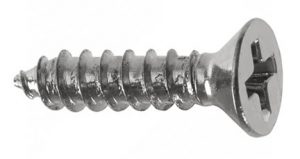 Choosing the right screws is important when assembling or fastening parts to sheet metal. Whether it’s made of steel or aluminum, sheet metal is harder than wood. As a result, you can’t use standard screws with it. You’ll need to use sheet metal screws. Below are five facts about sheet metal screws.
Choosing the right screws is important when assembling or fastening parts to sheet metal. Whether it’s made of steel or aluminum, sheet metal is harder than wood. As a result, you can’t use standard screws with it. You’ll need to use sheet metal screws. Below are five facts about sheet metal screws.
#1) Fully Threaded Shank
All sheet metal screws have a fully threaded shank. The shank is the long and slender body portion of a fastener. Both screws and bolts have a shank, which features external threading. Sheet metal screws, however, have a fully threaded shank. The external threading runs from the head all the way to the tip.
#2) Available in Self-Tapping
There are self-tapping sheet metal screws available. They don’t require the use of a pilot hole to install. Rather, self-tapping sheet metal screws create their own hole when driven into sheet metal. You can identify self-tapping sheet metal screws by their tip. They don’t have a traditional pointed tip. Instead, self-tapping sheet metal screws have a drill-like tip that’s able to dig into sheet metal.
Not all sheet metal screws are self-tapping. Some of them have a traditional pointed tip. Nonetheless, many sheet metal screws are self-tapping because they can create and “tap” their own hole.
#3) Carbon Steel
You can find sheet metal screws made of different materials. With that said, carbon steel is the most common material used in their construction. Carbon steel is an iron alloy that contains a higher concentration of carbon than traditional steel and stainless steel. Carbon is exceptionally strong. Therefore, sheet metal screws made of carbon steel are naturally strong as well.
#4) Variety of Drive Types
Sheet metal screws are available in a variety of drive types. The drive type of a sheet machine metal screw is determined by its head. To install a sheet metal screw, you’ll have to use a tool to grip and turn the head. Some sheet metal screws have a Philips drive type, whereas others have a hex drive type. When shopping for sheet metal screws, you should check the head to determine its drive type.
#5) Countersunk
When inspecting the head of a sheet metal screw, you may notice that it’s flat. Even if a sheet metal screw doesn’t have a slotted drive type, the top of the head may be flat. When combined with a canonical underside, this flat design allows for a countersunk installation. The sheet metal screw will sink into the workpiece during installation so that its head remains flush with the top of the workpiece.



